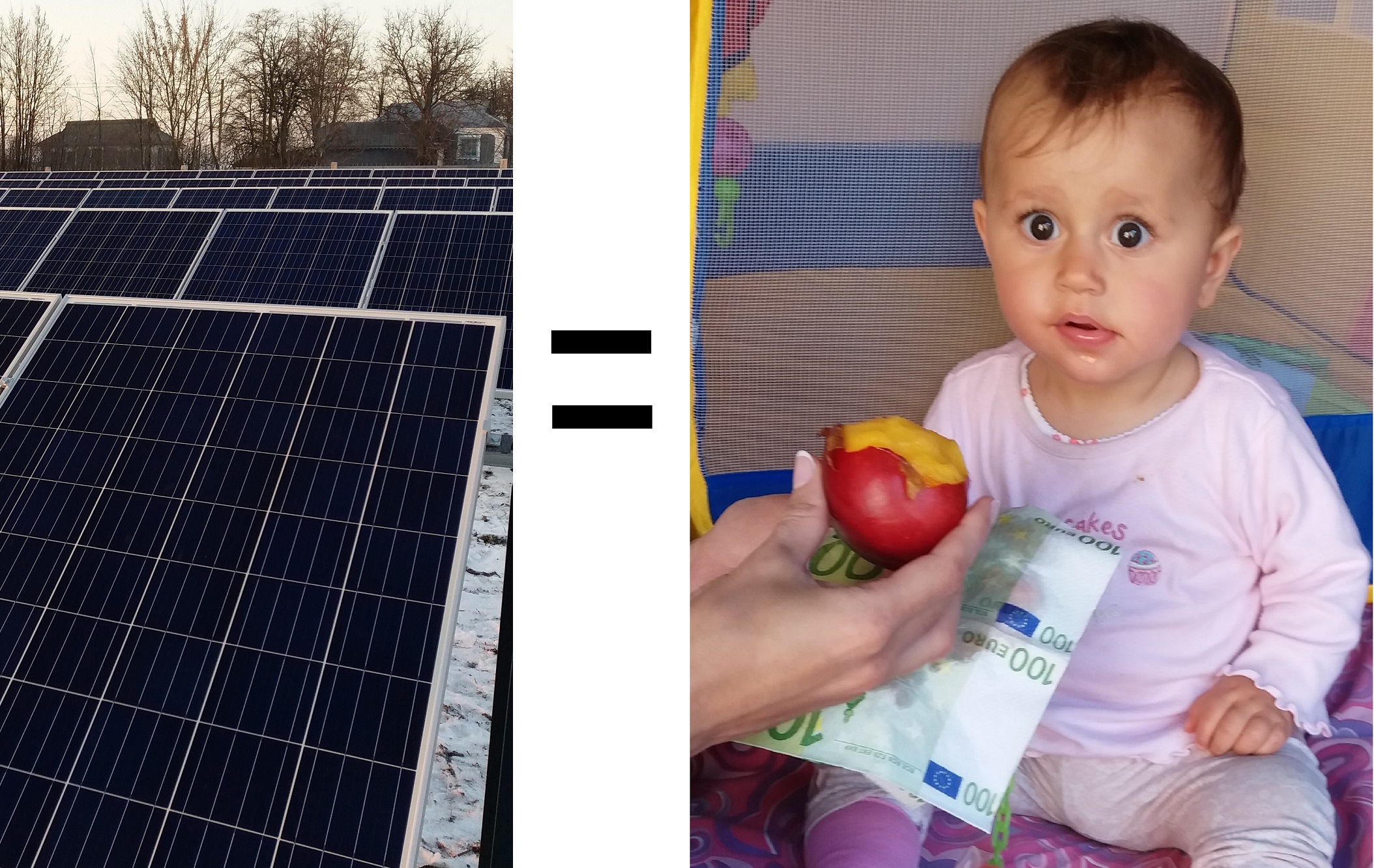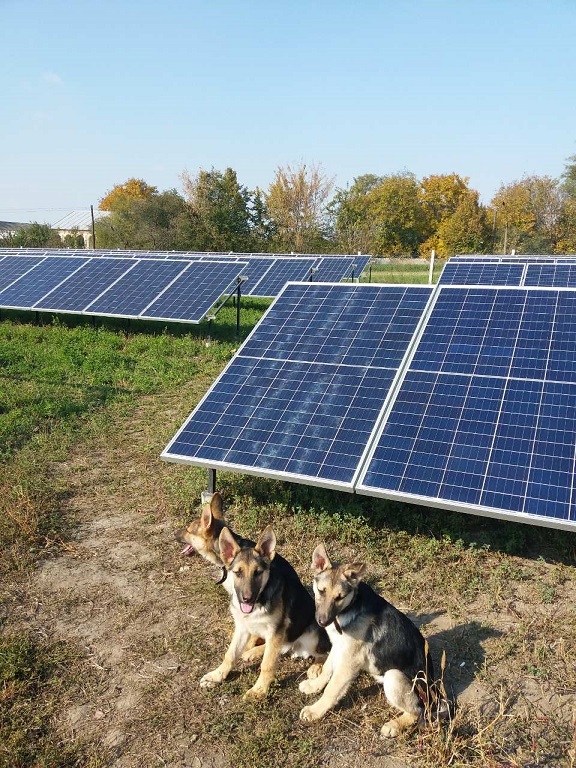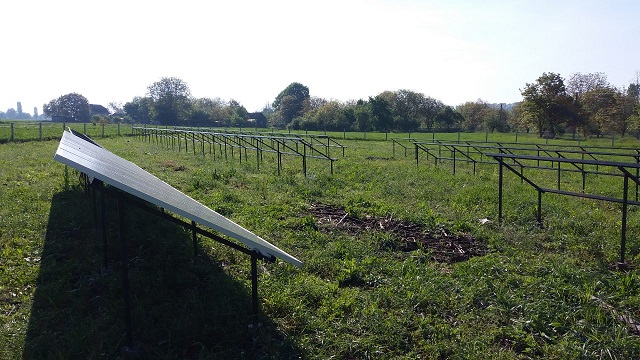We earn on solar energy or passive income of 25% per annum, practical experience

KDVP © Diana, made by Siuzanna
I will try to share the experience gained in (almost) self-building and operating a number of my home solar stations (DSES) under the Green Tariff (GP) in Ukraine, and what came of it.
The writing of the article was planned in the spring of 2019, but due to a number of legislative initiatives, it was repeatedly postponed. Now all the laws (I really hope) are finally adopted, and you can continue, well, or start. You have almost no time left to build and get a high tariff this year. And you should already be standing with an application for raising power to 30kW. Everything else you have time. Of course, if you want to make money on it, more about that.
Over 10,000 families have already invested in the construction of DSES in Ukraine. Each had their own motives, but it is obvious that the Green Tariff and the opportunity to earn money at the solar station served as the main motive.
At the same time, many blindly trust in an advertisement or organization that they have chosen as a contractor.
I hope my experience will avoid a number of errors at the design stage.
My idea of investing in DSES appeared in 2017, after analyzing the available options for obtaining passive income.
Introductory
He had experience in the IT business, a little in DIY, construction. Availability of free time, resources and desire.
To implement the plan, N rural houses were bought. The construction was carried out in several iterations, which helped to avoid early errors in subsequent stations.
Part 1. Economic
Theory
In Ukraine, one of the highest HR in Europe at the moment is operating, namely, 0.181 Euro per kWh for DSES commissioned before December 31 , 2019 and 0.16 Euro for DSES commissioned in 2020-2024.
ST will be valid until 12/31/2029 (
From it you need to deduct the income tax of 18% and the military duty of 1.5%. The tax agent is the oblenergo (guaranteed buyer) themselves, that is, the amount already paid minus all taxes. It will not work to optimize losses due to the opening of its FOP (PE).
Payments are received to the current account, which leads to additional losses of 0-1%, depending on the interpretation of the law and the selected bank.
In total, you really get ~ 0.145 Euro after taxes. The course is set as average, with reference to the last quarter. There are nuances with both the binding itself and the entry into force of these courses, but we will not talk about sad things. It is hoped that everything will stabilize and will go according to plan.
Home SES are allowed with power up to 30 kW (we will skip a special case of 50 kW on the roofs), and should be located on the territory of a private household. A guaranteed buyer is required to buy all generated electricity, regardless of whether he likes it or not.
The difference between generation and consumption is paid within the calendar month.
The whole process from increasing power to obtaining a ST is clearly spelled out in the laws and involves a simple step-by-step algorithm for transferring documents to a number of instances. The enforcement body (NKREKP) monitors the implementation of the law with its fines and other things.
A lot of companies that offer to build a turn-key 30 kW DSES and receive income of 25% per annum in foreign currency.
Total theory - we build, we get 3T, profit.
The most important thing is the calculation
The phrase "And the Sun shines equally for everyone" - alas, not true. After delving into the question, I found a useful and free online resource - PVGIS , which allows you to pre-evaluate what we get by building a station in a particular place. It is generally correct, but with a number of practical amendments.
Theoretically, 30 kW of panels should produce 28-38 MW * h per year, depending on the geographical location (most of the territory is 31-33 MW * h).
In my chosen region, the calculator predicted about 34,000 kWh of annual output, for a station with panels with a capacity of 30 kW.
We believe that the cost of the average DSES at the end of 2017 / beginning of 2018 was 30-35K USD
Many companies bring profit before taxes, indicate income of 6100 Euros for a 30 kW station, which is nice, but alas, not true.
Theoretically, we should make a profit of around 5,000 Euro per year, after taxes.
Total payback of the network 30 kW DSES under the green tariff was about 5-6 years, and if there is own consumption, then even more.
There are only two options to achieve a profitability of 25% - to reduce the cost of the station and / or increase its production. If there is time and desire - it is worth going both ways.
I would divide the costs of the station into 2 parts:
- equipment (inverter, solar panels, cables, structures)
- the whole complex of additional measures (in my case, a house, land, documents, power supply, fence, Internet, alarm, video surveillance, etc.).
In all price tags, only the first part is indicated, and then with lightweight designs. You will learn about the second part in the process. In my case, the cost of additional activities was comparable to the price of equipment, despite the fact that the price of the houses themselves was small.
Therefore, the task was to increase profitability, having a stable ballast of additional costs.
We cut out intermediaries
Having found a distributor (we write to the manufacturer, or visit the exhibition), you could save a significant part of the budget. The wrap on the solar panels was about 2+ K per set, 1+ K on the inverter, 2-4 + K on structures and works. Now the margin as a whole has fallen, but at the same time a bunch of “specialists” have appeared, from whose work even my hair, by no means a specialist, stands on end.
For this, the “sweet future” was lost - support and guarantee from resellers. But I have little faith that 50% of solar companies will survive a 5-year milestone, not to mention a 10-year one. And since the house is not alone, it made sense to bother yourself with a guarantee and additionally gain access to wholesale prices.
The main thing is not to “fan out” on saving and buy used from Europe. Communicated with many people who conducted tests of used solar panels, from different supplies. A lot of total defects and deviations from the parameters. Again, the cost of a set of work / materials per panel is quite high, and starts at $ 25. Therefore, the purchase of 2 new 300W panels for $ 200 and the purchase of 3 used 200W panels for $ 150 will come at almost the same price after installation, but you get new equipment and with a guarantee.
Total: 0% to production, -15% to price)
Cent Euro saves! We increase and maintain production
Item 1. Overload "in the sun"
The law clearly spells out only the power of the generating unit, namely the inverter, and it should not exceed 30kW. But how many panels will be - no one cares, although it is nominally declared.
Based on other people's experience, it was decided to set a larger solar field, namely 33.6 kW of panels, which in theory should give 38000 kWh per year.
Based on the results of a year of operation, it was decided to expand the solar field to 40 kW, which leads to a total loss of only 2%.
Total: + 10MW * h per year compared to 30kW (+ 30% to generation, + 18% to price)
Point 2. Economical designs
The price offers include roof mounts for solar panels. Total 2 cross rails + screws and fasteners for panels. But to find a roof, which will fit 30 kW of panels (200 sq. M.), With an orientation to the South, is practically not realistic. Again, the roof structure leads to 10% or more losses, due to poor ventilation and as a result of overheating.
Therefore, the overwhelming majority, if not all, of the 30 kW stations are made on ground structures.
Here begins the zoo of designs of all colors and sizes.
But the single-row construction of ferrous metal, with the panel mounted on bolts, is the most economical in terms of implementation, but not labor intensive.
If the work is done partly on its own or at a reasonable price, you can get significant savings.
I estimate the cost of a single-row design at $ 20 per panel (materials, work, fastening, installation) * rural coefficient for work.
It is also very easy to maintain - wash, check.
Total: + 5% to production, -5 (10)% to the price
Point 3. Avoid Shading
Houses for the construction of DSES were purchased taking into account the proximity to the substation and the absence (minimization) of shading.
For ground-based execution of the 40 kW station, about 12 acres of land are needed. This will give the absence of mutual shading throughout the year (will help to avoid those same "hot spots" in the winter), to recede from the neighbors (neighboring wars are sacred). Also, it will allow not to build a multi-row “sail” from the panels.
At first glance, slight shading can lead to large losses . To combat it, it will be necessary to deliver more panels (or lose output). Think about it.
Total: 0 to losses, + 5% to the price
Point 4. Reliability + redundancy + minimization of losses
We minimize network losses. All losses to the counter - are borne by the costs.
We create spare parts for quick replacement of burned equipment (yes, it burns). Every hour of downtime is quite expensive. Sometimes it can stand for 2-3 days while the RES or equipment is traveling (everything is under the seals, climbing itself is sometimes fraught).
Remote monitoring for quick response.
We use high-quality equipment.
Total: 0 to losses, + 0.5% to the price
Having carried out the above series of events (taking into account the falling prices on the panels), at the moment for the same 30K USD you can get a reliable and good home solar station with a solar field of 40kW, an annual generation of 45+ MW * h per year, and a practical payback of 4 years . At the same time, own consumption tends to 0 .
Ongoing costs are highly dependent on what they contribute.
There are few direct costs — check the connections a couple of times a year, wash the panels a couple of times a year.
And then the choice is yours:
- buy weed control or mow the lawn
- central guard / guard or guard yourself
- the Internet was already on the site or keep your own
- insure or believe in luck
In order to have less faith in luck and complete the whole set of measures,
And of course put on the contentment of the most important guards

You can try to shrink the amount, but I have big doubts about the reality of building such a station cheaper than 25K (using new high-quality equipment).
PS We throw the hat forward. “And then I’ll plant the lights”
As indicated at the beginning, nobody cares how many panels are installed at the station. For commissioning, the minimum number of panels is enough, the main thing is that the inverter starts.
Therefore, especially now, on the verge of changing tariffs and even in the autumn-winter period, it makes sense to build, launch and receive a ST at the station with the minimum possible number of panels. But in the early spring, when there is no excitement, there is a very big reason for throwing the panels to the maximum for completely different money (a seasonal decline is imposed on the tariff + technology change).
Waiting for the season

PPS The practical documentary part and the technical part came out very voluminous, and I decided to cut it out of the description. If there is interest, I can describe the equipment and solutions that were used.
Also welcome to the forum , which will help with answers to basic questions. I will be glad to answer questions both here and on the forum.
All Articles